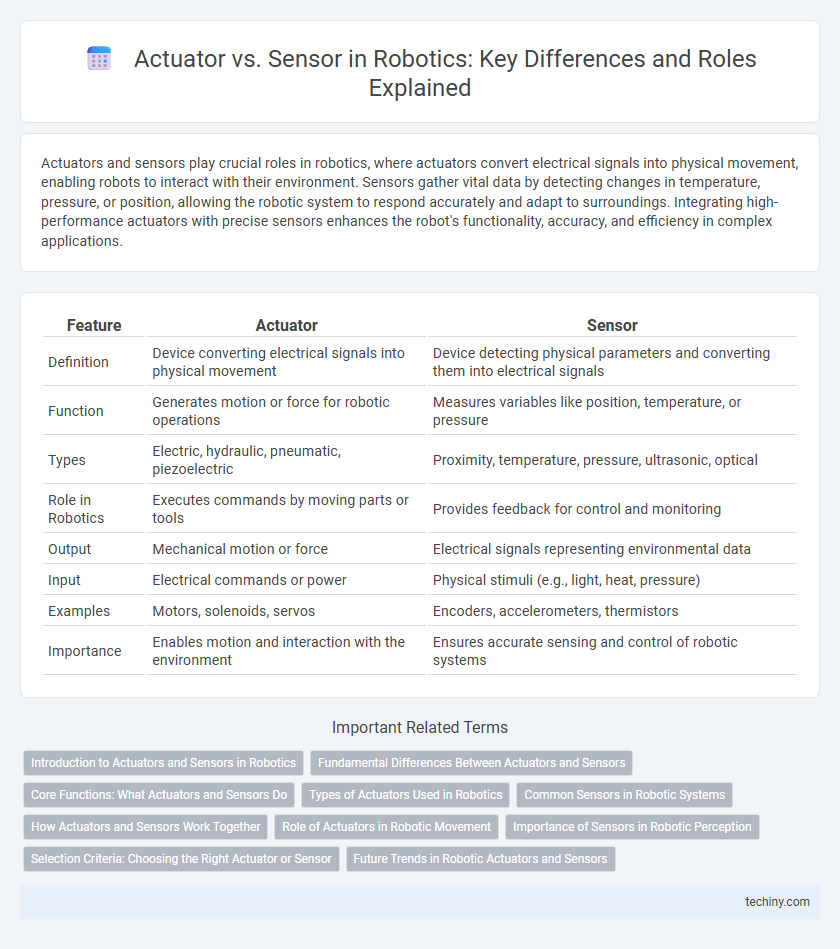Actuators and sensors play crucial roles in robotics, where actuators convert electrical signals into physical movement, enabling robots to interact with their environment. Sensors gather vital data by detecting changes in temperature, pressure, or position, allowing the robotic system to respond accurately and adapt to surroundings. Integrating high-performance actuators with precise sensors enhances the robot's functionality, accuracy, and efficiency in complex applications.
Table of Comparison
| Feature | Actuator | Sensor |
|---|---|---|
| Definition | Device converting electrical signals into physical movement | Device detecting physical parameters and converting them into electrical signals |
| Function | Generates motion or force for robotic operations | Measures variables like position, temperature, or pressure |
| Types | Electric, hydraulic, pneumatic, piezoelectric | Proximity, temperature, pressure, ultrasonic, optical |
| Role in Robotics | Executes commands by moving parts or tools | Provides feedback for control and monitoring |
| Output | Mechanical motion or force | Electrical signals representing environmental data |
| Input | Electrical commands or power | Physical stimuli (e.g., light, heat, pressure) |
| Examples | Motors, solenoids, servos | Encoders, accelerometers, thermistors |
| Importance | Enables motion and interaction with the environment | Ensures accurate sensing and control of robotic systems |
Introduction to Actuators and Sensors in Robotics
Actuators and sensors are fundamental components in robotics, enabling machines to interact with their environment through movement and perception. Actuators convert electrical signals into physical motion, powering joints, wheels, and robotic arms, while sensors detect stimuli such as temperature, pressure, proximity, and light to provide critical feedback for control systems. The integration of precise actuators and high-resolution sensors enhances robotic accuracy, efficiency, and adaptability in complex tasks.
Fundamental Differences Between Actuators and Sensors
Actuators convert electrical signals into physical movement, enabling robots to interact with their environment by controlling mechanical systems such as motors, valves, or limbs. Sensors detect and measure physical properties like temperature, pressure, or motion, providing critical data that guides robotic decision-making and feedback loops. The fundamental difference lies in actuators acting as effectors executing commands, while sensors function as input devices gathering real-time environmental information.
Core Functions: What Actuators and Sensors Do
Actuators convert electrical signals into physical movements, enabling robots to perform tasks such as gripping, lifting, or navigating. Sensors collect data from the environment, detecting variables like temperature, pressure, or proximity to inform robot decision-making. The interplay between actuators and sensors is fundamental for precise control and adaptive responses in robotic systems.
Types of Actuators Used in Robotics
Robotics employs various types of actuators, including electric motors, hydraulic cylinders, and pneumatic actuators, each offering specific advantages in precision, strength, and speed. Electric motors, such as servo and stepper motors, enable precise control for robotic arms and manipulators, while hydraulic actuators deliver high force for heavy-duty tasks. Pneumatic actuators use compressed air for lightweight, fast movements, often applied in pick-and-place operations and grippers.
Common Sensors in Robotic Systems
Common sensors in robotic systems include ultrasonic sensors, infrared sensors, and LIDAR, which provide critical environmental data for navigation and obstacle avoidance. These sensors convert physical stimuli such as distance, light, and sound into electrical signals that the robot's control system can process. Accurate sensor data enables precise motion control, enhanced situational awareness, and improved decision-making in complex robotic applications.
How Actuators and Sensors Work Together
Actuators convert electrical signals into physical motion, enabling robots to perform precise movements, while sensors provide real-time feedback by detecting environmental changes and monitoring actuator performance. The synergy between actuators and sensors allows for closed-loop control systems, ensuring accuracy, adaptability, and improved robotic functionality. Effective integration of these components enhances automation in applications such as manufacturing, autonomous vehicles, and medical robotics.
Role of Actuators in Robotic Movement
Actuators convert electrical signals into mechanical motion, enabling precise control of robotic limbs, joints, and wheels. They play a crucial role in executing complex movements by translating commands from the robot's control system into physical actions. High-performance actuators improve robot agility, speed, and accuracy, directly impacting overall functionality and task efficiency.
Importance of Sensors in Robotic Perception
Sensors are crucial in robotic perception as they enable robots to detect and interpret environmental inputs such as temperature, distance, and motion with precision. Unlike actuators that execute movements, sensors provide real-time data essential for decision-making and adaptive responses in dynamic settings. High-quality sensors enhance the robot's ability to navigate, interact safely, and perform complex tasks autonomously.
Selection Criteria: Choosing the Right Actuator or Sensor
Selecting the right actuator or sensor in robotics involves evaluating key criteria such as precision, response time, and environmental compatibility to ensure optimal performance. Actuators require assessment of torque, speed, and power consumption, while sensors demand accuracy, range, and signal stability. Compatibility with the robot's control system and application-specific requirements ultimately drive the choice between different actuator or sensor models.
Future Trends in Robotic Actuators and Sensors
Future trends in robotic actuators emphasize increased precision and energy efficiency through the integration of advanced materials like electroactive polymers and smart composites. Concurrently, sensor technology is evolving to incorporate AI-driven data processing, enabling real-time environmental adaptation and enhanced multimodal sensing capabilities. The convergence of these innovations is driving the development of autonomous robots with superior responsiveness and predictive maintenance features.
actuator vs sensor Infographic

 techiny.com
techiny.com